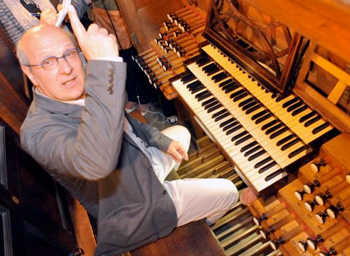by Daniel Hathaway

Normally obscured from view by the smaller of the instrument’s two cases, on Tuesday the performer’s every move was projected on a video screen. Bouvard took advantage of the situation by turning toward the camera to give informal introductions to each section of the recital. He apologized for his English, but no need: he came across charmingly and his remarks were brief and informative.
In a set of 16th-century dances and chansons by Claude Gervaise, Pierre Sandrin, and Clément Janequin, Bouvard drew period colors out of the organ. A bright plenum, a snarly kromhoorn, and octave flute stops served the rhythmically catchy music perfectly. A set of fantasies on Une jeune Fillette by Eustache Du Caurroy brought out the instrument’s spicy tierce combinations — involving pitches twelve and seventeen notes above unison.
Louis Couperin, uncle of François “Le Grand,” was represented by four fantasies that extended Bouvard’s color choices to principals, reed stops, and the Grand Jeu — a fiery combination of reeds and off-unison pitches.
Leaving France behind, Bouvard journeyed north with a Praeambulum in d by Heinrich Scheidemann and a three-verse setting of the Dutch tune for Psalm 24 by Anthony Van Noordt, the latter featuring an ornate variation with fleet-fingered passagework from the organist.
Bouvard characterized Mendelssohn’s Variations sérieuses as the composer’s most distinguished piano work, then played it in a fine organ transcription by the Dutch organist and composer Reitze Smits. If its seventeen flights of fancy proved to be a workout both for Bouvard and his stop-pulling assistants, hearing the piece was a sheer delight for the audience. It sounded completely natural on the organ, and Bouvard sailed expressively through its considerable technical challenges.
The recital ended with a transcription of a transcription — André Isoir’s arrangement of Bach’s Concerto for Four Harpsichords, which is itself an arrangement of Antonio Vivaldi’s Concerto for Four Violins. Confessing that he could hardly hope to replicate the work of eight hands with only his two, Michel Bouvard gave a scintillating performance of the work, creating moments of high drama along with trademark Vivaldian effervescence. Along the way, he brought his excellent sense of touch and articulation to bear on what must be one of the longest melodic and harmonic sequences in the literature.
Bouvard made an excellent impression on the large audience, who gave him a rousing ovation. His encore, an old French Noël with four variations, was an homage to his composer-organist grandfather, who studied with Louis Vierne at Notre-Dame in Paris.
Photo: Bouvard at the Cavaillé-Coll organ at the Basilica of St. Sernin in Toulouse, where he is the tenured organist.
Published on ClevelandClassical.com October 30, 2017.
Click here for a printable copy of this article


